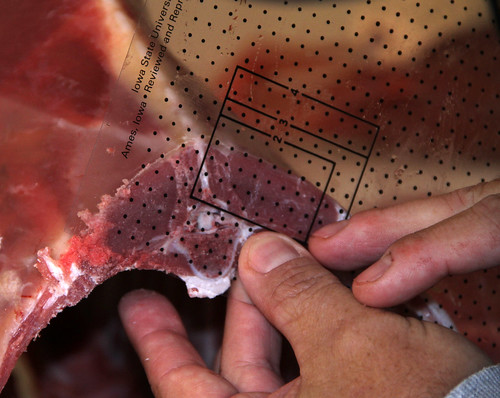As a follow-up to last year’s goat carcass evaluation study, a larger, more formal study will be conducted in 2012 to compare the performance, carcass quality, and economics of pen-fed vs. pasture-fed goats. Last year's preliminary study showed that pen-feeding improved goat carcass quality and value.
Fifteen (15) male goats will be penned and fed a diet consisting of free choice grass hay and limit-fed grain. The grain diet will be a balanced ration of whole barley and a pelleted protein supplement. The goats will be fed once daily and allowed to consume all the grain they can eat in 20 minutes, after which time the feeders will be removed from the pen. Rumensin (coccidiostat) will be provided via free choice minerals.
Each goat in the pen will have a “mate” of similar size and genetics on pasture. The fifteen (15) pastured goats will graze with the goats participating in the Western Maryland Pasture-Based Meat Goat Performance Test. They will consume a pasture-only diet that includes various cool and warm season grasses. Free choice minerals, containing a coccidiostat, will be available.
To do the study, we need pairs of intact male goats that weigh around 40 lbs. (each) at the start of the study on June 2. One goat from the pair will be pen-fed. The other will be pasture-raised. Both groups will be handled similarly.
We would like for consigners to the goat test to provide some or all of the goats for the study. A fair market price will be paid for the ~40 lb. goats. The same data that is collected on the test goats will be collected on the goats in the carcass study. All of the goats designated for the study on June 2 will be slaughtered.
The study is being funded by a grant from the Maryland Grain Producers Utilization Board.
Fifteen (15) male goats will be penned and fed a diet consisting of free choice grass hay and limit-fed grain. The grain diet will be a balanced ration of whole barley and a pelleted protein supplement. The goats will be fed once daily and allowed to consume all the grain they can eat in 20 minutes, after which time the feeders will be removed from the pen. Rumensin (coccidiostat) will be provided via free choice minerals.
 |
| Measuring the rib eye of one of last year's goats |
To do the study, we need pairs of intact male goats that weigh around 40 lbs. (each) at the start of the study on June 2. One goat from the pair will be pen-fed. The other will be pasture-raised. Both groups will be handled similarly.
We would like for consigners to the goat test to provide some or all of the goats for the study. A fair market price will be paid for the ~40 lb. goats. The same data that is collected on the test goats will be collected on the goats in the carcass study. All of the goats designated for the study on June 2 will be slaughtered.
The study is being funded by a grant from the Maryland Grain Producers Utilization Board.











